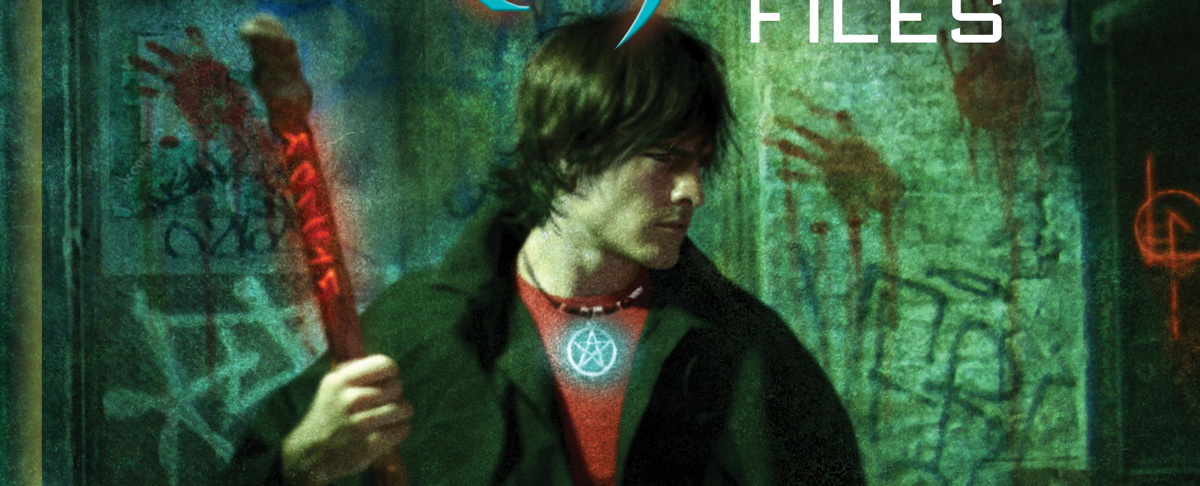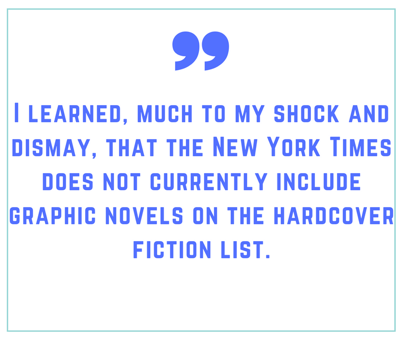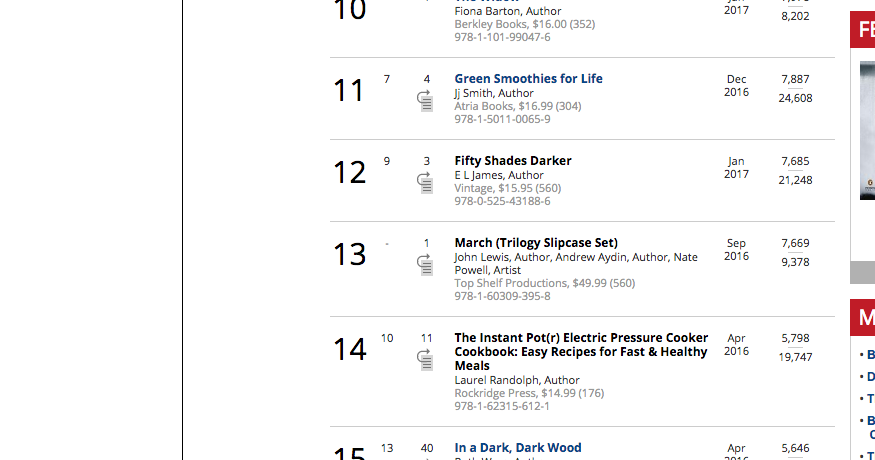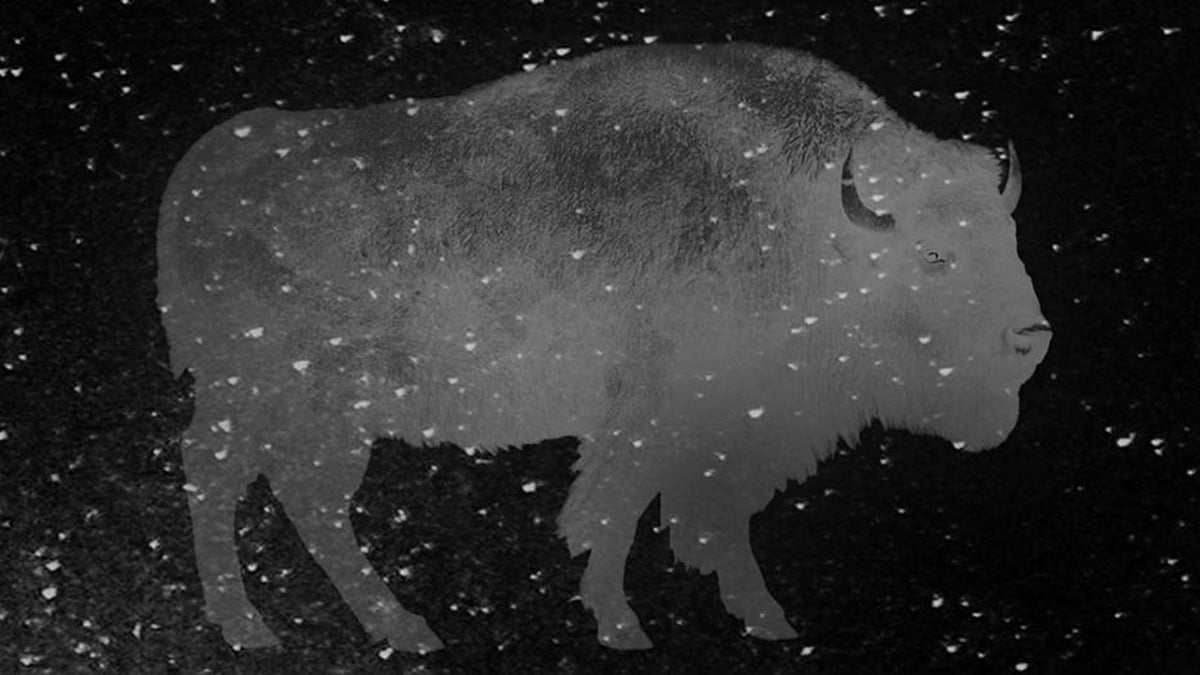The publishing industry is still in shock over the New York Times’ sudden decision to remove several of their bestseller lists – all done without telling publishers first.
While many categories were affected by this, the outcry from the graphic novel/comics community was the loudest. And it was also the ONLY top lined category – along with fiction, nonfiction and children’s books – to be removed.
The outcry prompted NYT Book Review editor Pamela Paul to respond on twitter to an all-star cast of alarmed bestselling authors.
.@goraina Just to be clear: Comics will still be counted on the main lists, as they were before we spun them off separately.
— Pamela Paul (@PamelaPaulNYT) January 26, 2017
Paul also responded to the tweet, reported here yesterday in which she seemed to dismiss March Book Three as a kids book – not an insult in itself but coupled with continually calling comics a genre instead of a medium, and the “hey kids!” opening it had a shady cast.
Refering to a book as a children's book is an honor, not an insult. Some of the best books are written for young people and read by all.
— Pamela Paul (@PamelaPaulNYT) January 27, 2017
"March" was written for kids grade 8 and up, but deserves to be read by a wider audiences, as do many kids' books, no matter the format. https://t.co/zexx8e5Usl
— Pamela Paul (@PamelaPaulNYT) January 27, 2017
Paul also revealed more of the reasons why the Times made the cuts to begin with: cutting costs at the increasingly beleaguered news giant.
Because we don't have unlimited resources and want to focus on ways that bring the most readers to GN and comics. 1/2
— Pamela Paul (@PamelaPaulNYT) January 27, 2017
More than you would think. Meticulous and thorough data collection, fact checking, copy editing, layout.
— Pamela Paul (@PamelaPaulNYT) January 27, 2017
To be fair, the Times didn’t just reprint the Bookscan numbers, they used reports from indie booksellers and other metrics to create a unique, hand-crafted bestseller list. Cutting these lists down is definitely a money saving move, but despite Paul’s continuing protests, graphic novels benefitted the most from the list as a validation of the medium’s growing importance. In addition, the timing couldn’t have been less appropriate, as graphic novels sales are still growing at a time when other book genres are flat or dropping.
The importance of the lists was discussed by a variety of industry figures in a piece at Vulture.
The second issue is one of legitimacy. When the Gray Lady set up isolated categories for graphic literature, it was a godsend for struggling creators and publishers because, all of a sudden, you had a shot at being able to promote yourself as a New York Times best seller. That’s not insignificant. Beyond that, it was just nice that comics were important enough to be acknowledged and tracked by the paper of record. All that’s gone now. “It certainly isn’t good for business,” Reynolds adds. “Good comics have forever had to scratch and claw for legitimacy and resist marginalization, and this feels like a step backwards on that front.”
Despite Paul’s repeated assurances that GNs would be represented in the best seller lists when sales warranted, the entire history of this list is troubling in some ways. Both the GN list and the also-removed Children’s Middle Grade Paperback lists were created because Times editors were sick of comics and Harry Potter making the regular list.
Although never openly reported, after a graphic novel showed up on the Times Best seller list in 2007 (either Watchmen or a Batman book), the Times decided that they would no longer include graphic novels on the main fiction lists, despite a history of their being included as sales warranted.
Even 10 years ago, GNs were a fast growing category. A post by former Del Rey publisher Betsy Mitchell on the Unbound blog from 2008 actually talks about what happened. Because the post was written nearly 10 years ago and so much of it is relevant to the current situation, I’ll take the liberty of excerpting a lot of it. Mitchell started out talking about how The Dresden Files: Welcome to the Jungle, a comics adaptation of the popular series by Jim Butcher, had sold so many copies she thought it might make the Times best seller list.
On Wednesday Bookscan released its sales figures, and Welcome to the Jungle appeared at #17 on the hardcover fiction list. (Bookscan is a database that tallies actual sales from bookstores and other outlets nationwide. It doesn’t cover 100% of the marketplace, but it’s the most accurate reference publishers have as to how our books are doing week by week.) My pulse rate went up. Bookscan doesn’t predict the New York Times bestseller list slot by slot, but it’s a very strong indicator for where, in general, a book will land. Welcome to the Jungleseemed a real possibility for the top 15, which is the part of the list that actually appears in print in the Times Sunday book section.
Wednesday evening came around, the Times list was released electronically to publishers, I fell upon it with glad cries . . . and was dashed to the rocks below. No Jim Butcher, anywhere. Not only was it missing from the top 15, it appeared nowhere in the Extended List. Nada. Zip. Much wailing and gnashing of teeth ensued.
So what did I learn this week?I learned, much to my shock and dismay, that the New York Times does not currently include graphic novels on the hardcover fiction list.
The concept had never entered my mind. A graphic novel is fiction. Jim Butcher has landed numerous times previously on the Timesbesteller list. The book outsold, nationally, all but 16 other hardcover fiction titles for the week ending 10/19. Why wouldn’t it have been included?
As a result of my ranting around the office Thursday morning, the head of publicity contacted the Times to find out why Welcome to the Jungle had been dissed. “Well, there’s actually an answer,” she reported. “Even though they have included graphic memoirs and nonfiction like Persepolis and Art Spiegelman books on the list, they have not been tallying graphic novels. HOWEVER: they are planning to start a separate list of graphic novels, if not by the end of this year then very early next year.”
The Times told him the same thing back in August, said Paul Levitz, president of DC Comics, when I called to find out whether he’d had the same problem. DC sold enormous quantities of Alan Moore’s Watchmen over the summer; I hadn’t noticed then that the Timesdidn’t list it.
DC has even more reason to be aggrieved. Watchmen, aside from selling so many copies in early August that it ended up at #2 on the Bookscan trade paperback bestseller list, has been named by Time magazine as one of the Top 100 Novels of All Time [mark that, New York Times: NOVELS–TOP NOVELS of All Time!!!
It has not always been thus. Those who have been in the comics world for years tell me that Sandman made the list; there might have been others. “Welcome to our world,” people told me cynically as I repeated my tale of woe to anyone who would listen. “Glad you’re on the team.” And so I guess I am on the team, if it’s the team’s job to shake up those in publishing who don’t consider graphic novels equal to other fiction.
Many others before me have spoken eloquently on this topic. I’m very new to the world of graphic novels, but have become an ardent admirer of how a talented artist can become responsible for as much of the storytelling as a writer. Would love to hear others’ opinions on whether graphic novels “deserve” inclusion with other fiction.
Obviously there has long been some institutional bias against graphic novels as a legitimate medium at older cultural guardians like the Times, and what happened in 2008 was a lingering remnant of that. (The endless presence of Garfield and Simon Bond cartoon books on the trade paperback best seller lists throughout the 80s also prompted the Times to adjust how they ran those lists so that it wouldn’t be all comics.) To be fair to Paul, all this took over long before she took over the NYT book review section last year, and she’s obviously open to engaging with the outraged comics community – although she may be learning fast that that is an endless task.
There’s one other matter that was raised because of the times, best expressed by creator Taneka Stotts on twitter:
https://twitter.com/neekaneeks/status/824649502833283074
Stotts is referring to the surge in sales for March Book Three and the entire trilogy following the dustup between John Lewis and Donald Trump.
While I think all the evidence – including March Book Three being the #1 book on the Times list for six weeks already, and the last list going out with an adaptation of Octavia Butler’s Kindred – suggests that this was NOT a deliberate motivation for the move, it actually did have the effect of not showing March’s sales.
In addition, and troublingly, the surge in sales also calls into question whether GN sales will actually be taken into account for the main list, as Paul has repeatedly claimed. Publishers Weekly runs a monthly graphic novels best seller list taken straight from Bookscan, and a number of other best seller lists. On the current week’s trade paperback list, the March Trilogy is #13 with 7685 copies sold in a week.
The NY Times list for the week only goes to #10, so the March Trilogy may just have missed the list. Still given its sales velocity, something the TImes list reportedly takes into account, it would have been a very likely book for the list.
At the end of the day, the Times Graphic Books bestseller lists often measured fairly incremental sales, but just listing books by NoBrow, D&Q, Fantagraphics and other indie publishers gave them a legitimacy that few other lists or awards could. LIbrarians have been especially dismayed by the end of the lists, as they used them to justify buying books.
As I write this, Paul is still out there trying to explain things, with varying degrees of success. The outcry is still strong, and I’d be very surprised if the Times didn’t at some point add GNs to its monthly “genre lists” at the very least. The days of “graphic books” as their very own category on the Times list may be over, but you haven’t heard the last of this scrappy little medium.
oh I give up pic.twitter.com/AQeB5MOAjW
— Jennifer de Guzman Strikes Again (@Jennifer_deG) January 27, 2017





 On Wednesday Bookscan released its sales figures, and Welcome to the Jungle appeared at #17 on the hardcover fiction list. (Bookscan is a database that tallies actual sales from bookstores and other outlets nationwide. It doesn’t cover 100% of the marketplace, but it’s the most accurate reference publishers have as to how our books are doing week by week.) My pulse rate went up. Bookscan doesn’t predict the New York Times bestseller list slot by slot, but it’s a very strong indicator for where, in general, a book will land. Welcome to the Jungleseemed a real possibility for the top 15, which is the part of the list that actually appears in print in the Times Sunday book section.
On Wednesday Bookscan released its sales figures, and Welcome to the Jungle appeared at #17 on the hardcover fiction list. (Bookscan is a database that tallies actual sales from bookstores and other outlets nationwide. It doesn’t cover 100% of the marketplace, but it’s the most accurate reference publishers have as to how our books are doing week by week.) My pulse rate went up. Bookscan doesn’t predict the New York Times bestseller list slot by slot, but it’s a very strong indicator for where, in general, a book will land. Welcome to the Jungleseemed a real possibility for the top 15, which is the part of the list that actually appears in print in the Times Sunday book section. The Times told him the same thing back in August, said Paul Levitz, president of DC Comics, when I called to find out whether he’d had the same problem. DC sold enormous quantities of Alan Moore’s Watchmen over the summer; I hadn’t noticed then that the Timesdidn’t list it.
The Times told him the same thing back in August, said Paul Levitz, president of DC Comics, when I called to find out whether he’d had the same problem. DC sold enormous quantities of Alan Moore’s Watchmen over the summer; I hadn’t noticed then that the Timesdidn’t list it.









As I said earlier, during the summer of 2008, when Watchmen was ostracized, the prose adaptation of “The Dark Knight” by Dennis O’Neil did chart on the paperback list.
Back in the 1950s, Pogo by Walt Kelly charted on the Fiction list. Since the comicstrips were reformatted into pages, it technically is one of the earliest graphic novels to appear on the NYTBS.
I believe Al Capp charted as well.
Milt Gross and the woodblock cartoonists might have as well, earlier.
—
Not to put you on the spot, Heidi, but what has Publishers Weekly done over the decades in regards to their bestseller lists?
The PW lists were formerly handcrafted by staffers in similar methods to the NYT, with reporting stores and projections. A few years, IIRC, after George Slowik bought PW, we signed a deal with Bookscan to run the actual charts but in much edited form.
Hmm. I’m saddest about the loss of the manga chart as really that’s the only us manga chart I ever see. But this sucks all round.
The Times bestseller lists were always poorly curated and failed to show accurate trends in popularity in the category. They failed, for instance, to adequately account for and excise academic market sales for Persepolis and Maus, leading to those two books showing up on the list again every year in September. And they made a negligible effort to account for direct market sales of titles.
Maybe I don’t understand how this is done, but if the Times is going to include graphic novels on the main list, it stands to reason that they will still have to calculate graphic novel sales in some fashion in order to accommodate that. How will not publishing those numbers save them much money?
>Could this have anything to do with MARCH? All signs for me point to YES!
Sure, that must be it. The most Liberal newspaper on the planet is out to cover up the success of a book about a Democrat. That’s just what they do there.
– “Refering to a book as a children’s book is an honor, not an insult.”
Refering to Pamela Paul as a liar is an honor, not an insult.
Comments are closed.